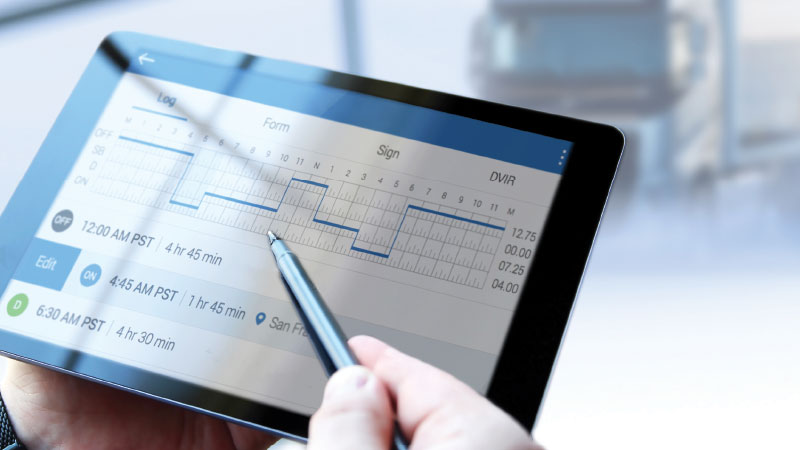the British Columbia Trucking Association
Now that electronic logging devices (ELDs) are on their way to becoming mandatory in all jurisdictions across Canada, it’s time for carriers to begin the process of fully implementing them in their vehicles. The majority of trucks on our highways already use ELDs, and we have had plenty of time to become well-versed in their use. Many early adopters have had a head start on ELD implementation and made the shift from paper logs to certified automatic electronic logs to ensure the transition goes smoothly. If you have not already, now is the time to investigate which certified device will work best for your fleet.
Originally set to be enforced in June, the Canadian Council of Motor Transport Administrators (CCMTA) recently announced that there would be an extension of the transition period for the ELD mandate. After monitoring the progress of jurisdictions across the country, they determined that additional time is needed for the industry to purchase and install certified ELD devices and conduct training to be compliant. Based on these factors, jurisdictions will continue to support the mandate through a period of education and awareness through to January 1, 2023.
Why the Mandate is Necessary
Let’s take a moment to remind ourselves of the intent of the mandate in the first place: ELDs are known to help improve safety standards, reduce the rate of preventable accidents and associated costs, and increase the accountability of companies operating in the industry. CCMTA notes that “mandatory use of these devices will help ensure federally regulated commercial carriers operating in Canada, including those that cross the border into Canada, will continue to drive within their hours of service (HOS).”1 Transport Canada estimates that the mandatory requirement for electronic logging devices will reduce the risk of fatigue-related collisions by approximately 10%.
ELDs offer several driver and operational advantages. Not only are they a helpful tool in lessening driver fatigue, but the use of such devices will also reduce administrative burdens, eliminating the need for daily paper logs and reducing the time needed for enforcement officers to verify regulatory compliance. With over $650 billion in goods crossing the Canada-USA border each year, work continues to educate American carriers to ensure that their vehicles operating in Canada are using approved, third-party certified devices. When the ELD mandate is enforced, every commercial vehicle over 11,794 kilograms operating on BC highways more than 160 kilometres from their terminal will be required to have a Transport Canada approved ELD. This ensures consistency with other Canadian jurisdictions.
The Impact on Industry
But what of the ELD critics who argue that the mandate has not had the positive safety impact promised by advocates? Studies in the United States have shown an increase in speed-related commercial vehicle accidents following the ELD mandate instituted in 2017. Specifically, a study by the University of Arkansas found that for carriers with one truck, unsafe driving violations increased by 26%, and for carriers with two to six trucks, unsafe driving violations increased by 16.7%.2
Given that drivers have no way to ‘adjust’ their driving time in an electronically compliant framework, the evidence indicates that many have attempted to compensate by speeding, which is why the BC Trucking Association (BCTA) is strongly recommending that speed limiter legislation be brought in force in harmony with a provincial ELD mandate.
In Canada, the provinces of Ontario and Quebec have both mandated the use of speed limiters. A 2014-2015 Ontario Ministry of Transportation study found that two years after requiring commercial vehicles with gross vehicle weights above 11,794 kilograms to set speed limiters at 105 km/h, speed-related at-fault collisions involving large commercial vehicles decreased by 73%.
Beyond the safety benefit, speed limiters are also a proven technology for managing fuel consumption. As fuel consumption and commensurate greenhouse gas (GHG) emissions climb exponentially with increases in speeds above 105 km/h, the proposed speed limiter mandate will result in a reduction of emissions. The exact magnitude of fuel savings and GHG reductions for BC is unknown due to insufficient speed, volume, and distance-travelled data. However, Ontario’s Ministry of Transportation determined that the combined effect of transportation initiatives in their province, which includes speed limiter regulation, was estimated to produce a GHG reduction of 4.6 metric tonnes by 2020.3
Dave Earle, BCTA President and CEO, is certain that BC will experience the same trend with mandated speed limiter use. “The inherent safety benefits of
this proposed mandate accompanied with the reduction in our sector’s GHG emissions is a win-win,” explains Earle. “It will save lives. Crashes involving heavy-duty vehicles travelling faster are more deadly than crashes involving these vehicles travelling at lower speeds –
it’s basic physics.”
A Catalyst for Positive Change
Fleets already keeping an electronic log of their driving records will have taken advantage of the new source of data generated by ELDs. Make no mistake, this information is incredibly useful in improving operations. Monitoring expenses like unnecessary vehicle maintenance and downtime, HOS violations, and safety-related fines helps companies to enforce best practices by encouraging drivers to operate safely. And carriers are utilizing this data as part of their retention plan – plans that incorporate ongoing professional development using driver metrics and new responsibilities that demonstrate career advancement to tackle driver shortage.
ELD adoption continues to drive our industry forward by identifying trends and opportunities to optimize processes and address the challenges we are facing today. The road to implementation will not be one without its ups and downs. However, it will lead to improved safety, increased sustainability, and effective business strategies for your fleet.
References
1. Canadian Council of Motor Transport Administrators (2022, March 7). Messages for Industry with Respect to the Federal Electronic Logging Device Mandate [Press Release]. www.ccmta.ca/web/default/files/PDF/ELD/ELDs%20-%20Messages%20for%20Industry%20-%20March%207%
202022.pdf
2. Alex Scott, Andrew Balthrop, Jason W. Miller 2021. Unintended responses to IT-enabled monitoring: The case of the electronic logging device mandate.
3. Ontario Ministry of Transportation. 2018. Evaluation of Ontario’s Speed Limiter Program for Large Trucks: A Study of
Safety Outcomes and Compliance Post 2009 Legislation. (p. 11).


 1-866-985-9791
1-866-985-9791



